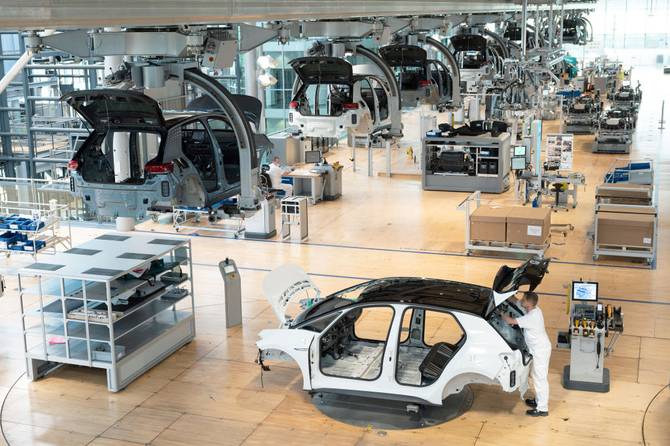Hey there. We’re here to remind you that Valentine’s Day candy is now on sale, and probably won’t expire by Employee Appreciation Day on March 3. Nothing says, “We care about morale and the bottom line” like bargain-buying office treats. Just don’t get the hearts that say “Kiss Me.”
In today’s edition:
 DE&I, meet KPIs DE&I, meet KPIs
 ‘Where the business and talent meet’ ‘Where the business and talent meet’
 Step on the gas Step on the gas
—Susanna Vogel, Aman Kidwai, Eoin Higgins
|
|
Illustration: Dianna “Mick” McDougall, Source: cienpies/Getty Images
From 2020 through 2021, tying executive pay to meeting diversity goals grew significantly in popularity, with companies including McDonald’s, Nike, and Starbucks tying some form of executive compensation to boosting gender and racial diversity in their workforces or in leadership positions.
Some companies, including those at the Golden Arches, opted to do so, at least in part, because some shareholders wanted it: Thomas DiNapoli, New York State comptroller, submitted one 2020 proposal that seemed to motivate McDonald’s to consider the issue. He withdrew that proposal when the company announced the compensation policy in 2021; that year, DiNapoli told Bloomberg Law the company had “taken a real step toward protecting its workforce” by doing so and that he hoped other companies would follow.
But elsewhere, other shareholders sometimes objected to the practice—and, in some cases, objected aggressively. Since 2022, at least four big-name companies have received retraction demands from a handful of right-leaning think tanks calling for an end to programs that tie executive compensation to diversity hiring. If companies don’t comply, one retraction demand warned, a lawsuit could follow.
In August of 2022, the American Civil Rights (ACR) Project made good on that threat when it sued Starbucks on behalf of a shareholder, the National Center for Public Policy Research (NCPPR), in Washington State alleging the comp policy created “racial prejudice against white job candidates.”
The suit specifically names SVP of HR, Jennifer Frisch, and its chief inclusion and diversity officer, Dennis Brockman, as defendants, alongside the company, CEO Howard Schulz, and 30+ other executives—a legal tactic that could have some HR professionals wondering about the unanticipated risks of such an executive compensation program. Keep reading here.—SV
|
|
|
“Data is beautiful.” At least that’s what they say. But securing the right data in an ocean of numbers, charts, and figures? Now that’s tricky, especially when it comes to finding the perfect HR metrics for tracking the health of your organization.
But it doesn’t have to be. Visier put together a 10 HR Metrics Every Company Should Track guide to help you secure all the insights you need. This bad boy offers all kinds of golden nuggets about HR data on topics like headcount, turnover, and diversity.
It’ll also show you how to:
- discover the most important HR metrics to track
- use HR analytics to drive business success
- get inspiration from the success stories of fellow HR leaders
Start lettin’ the data work for you.
|
|
JT Saunders
While working as the chief program officer for the Institute for Responsible Citizenship, a nonprofit focused on the advancement of Black students, JT Saunders noticed that the “high-achieving African American males” he worked with were struggling to get ahead in their careers.
“I was frustrated by that,” Saunders told HR Brew, “so I decided to leave nonprofit[s] and come to [the] corporate [world] and really understand how organizations were making talent decisions.”
He joined Korn Ferry as an executive recruiter in 2014, primarily working on CEO searches, before moving into a dual role—helping HR clients drive DE&I and culture change, while developing Black leadership initiatives. Since February 2021, he’s served as the consulting firm’s chief diversity officer.
In an interview with HR Brew, Saunders discussed the role of HR and DE&I work in today’s economic climate, and the lessons from his experiences in the field.
What are the most rewarding aspects of your work in HR?
Working in DE&I/HR can be quite rewarding because it is where the business and talent meet…These functions help to create the systems, structures, and best practices that help to optimize performance. We are positioned to advise business leaders on how to best incentivize, reward, recognize, and develop talent. It’s most rewarding to help activate an organization’s strategy through people and measure progress over time. In these roles, you see the impact you are having on others’ lives—which is absolutely priceless.
In what ways does the HR field still need to change?
Over the last 10 years or so, there’s certainly been a broader evolution around the HR profession, where it’s gone from being less about compliance…to being really a business driver for organizations via building culture, building engagement, and ensuring that you have the right reward systems and accountabilities in place to support an evolving workforce. Keep reading here.—AK
|
|
Sebastian Kahnert/picture alliance via Getty Images
Pandemic-era hiring sprees have resulted in a rash of recent layoffs, particularly in the tech industry. But as IT Brew’s Eoin Higgins recently reported, tech’s loss may very well be auto’s gain.
Cyber talent shortage is affecting every industry. Nadine Moore, a partner with Boston Consulting Group, told IT Brew that she sees challenges to companies across the board, including skills, education, and price—and that making adjustments on those bases is still of primary importance to any company with tech needs.
“I think that the automotive [companies] are thinking differently,” Moore said. “It’s not just hiring from their competitor neighbor, it’s actually thinking, ‘How do I go into tech? Is the blip in the tech economy right now an opportunity to grab talent?’ That would be a strategy I’d certainly think about.”
That’s good for IT workers looking to get into a different style of tech without the risk of joining a startup. The auto industry is in the midst of a major evolution—electric vehicles replacing internal combustion engines, autonomous vehicles, and more. Car software, too, is moving fast and redefining how we understand the function of the car, making it more of a computer or mobile device.
Now, car companies are desperate to beat the competition to the next generation of vehicles and the tech job market is, despite the layoffs, still tight.
Keep reading on IT Brew.—EH
|
|
Today’s top HR reads.
Stat: Real average hourly earnings for US employees decreased by 1.8% when seasonally adjusted from January 2022 to January 2023. (Bureau of Labor Statistics)
Quote: “It is unclear if these vendors have any anti-discrimination compliance obligations: When an employer uses their [AI tool] to make an employment decision, the vendor is neither the employer making an employment decision, nor an employment agency making such decisions on their behalf.”—Jiahao Chen, owner of Responsible Artificial Intelligence, calling for the EEOC to hold HR AI vendors accountable (Bloomberg Law)
Read: To understand non-compete agreements, visit a local hair salon. (the Wall Street Journal)
Learn: Do your finances make you flinch? Well, Money with Katie’s Wealth Planner can change that. Track your income, spending, investing, debt payoff, and more with this easy-to-use planner—get yours now.
Up close and personnel. The Georgetown Master’s in Human Resources Management prepares you to become an effective and strategic HR business partner. Attend a sample class, “Negotiation Skills and Strategies,” on March 7. Register now.*
*This is sponsored advertising content.
|
|
-
Twilio is cutting pandemic-era wellness benefits and sabbatical programs, with CEO Jeff Lawson calling them “ill-timed given our profitability goals.”
-
Walmart is closing three US offices and requiring hundreds of workers to relocate in order to keep their jobs.
-
Mars Wrigley was fined by OSHA following an accident in which two employees fell into a vat of chocolate.
-
Tesla employees in New York State have announced a union campaign.
|
|
Catch up on the top HR Brew stories from the recent past:
|
|
|







